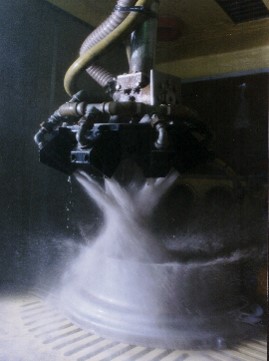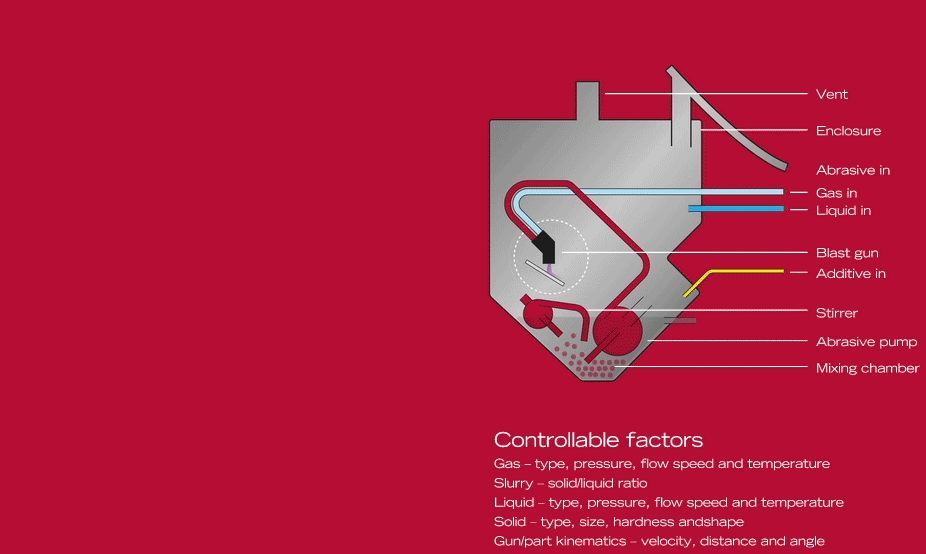What is wet blasting?
Wet blasting is the use of an abrasive media and compressed air to achieve a desired finish on a chosen surface.
With our core focus on process control and a design philosophy of “if you can measure it, you can control it”, our wet blasting machines are leading the way when it comes to repeatable and reliable processing.

Some of the key areas where our world leading levels of control and accurate wet blasting are explained below:
The type of abrasive media used in a Vapormatt wet-blast system is determined by the effect or finish you want to achieve. Typically, for example, our customers use glass beads for a satin polished finished, or an aluminium oxide for matt. Dependent on the application, you can also use special abrasive media, such as ceramic, plastics and stainless steel shot.

One of the main strengths of wet blasting over other finishing processes is the degree of control it gives you. That control comes as a result of the many different elements you can adjust individually…
Starting at the heart of any wet blast machine is the abrasive pump. This mixes, then delivers, the abrasive media and water in the form of a slurry. The slurry pump is necessary for delivering the slurry through a carefully designed network of hoses, connections and valves.
Key considerations in media mixing include:
- distance travelled from pump to nozzle(s)
- slurry pressures
- potential bottlenecks or wear points in the pipework system
- required density
Failure to consider these issues could lead to reduced performance or inconsistent blasting effects on the workpieces; ultimately adding to lead times and reducing overall quality of the wet blasted parts.
Slurry conditioning refers to the ability of a wet blasting system to manage both the quantity and quality of abrasive media within the wet blasting machine. Having too much or too little abrasive can either damage the slurry pump or slow down/limit the capability of the blasting process. Additionally having the right amount of abrasive, but in the wrong size or shape, can ultimately slow down the whole process and reduce the machines capacity.
Vapormatt have developed a large number of filtration systems that are rooted in a deep understanding of how different particles behave when suspended in water. Combining these proven sedimentation and cyclonic systems with proprietary concentration sensors gives the users much higher levels of reliability, with the knowledge that the slurry being delivered is the same slurry that was requested.
Having mixed, delivered and the ensured the quality of the slurry is correct it becomes of great importance to achieve the right effect on the surface that is required for the wet blasting application.
Critical factors in gun kinematics include:
- nozzle shape
- air jet size
- blast angle
- effective range
- number of guns being used
Without considering these variables an imbalance in the process can occur, reducing consistency over time. As the nozzles are subject to very high levels of wear, it is also important to monitor the air flows to each nozzle in order to determine when maintenance is required or, to extend nozzle life, what changes are required to the programming to maintain equilibrium.
Many other variables are also important but these top three should always be discussed when looking at wet blasting processes. To discuss a wet blasting application, control improvements to an existing machine or upgrades, contact our team today.
Watch Ryan Ashworth, Head of Sales and Marketing, presenting on the evolution and importance of process control for edge honing, peening and cleaning by wet blasting at GrindTec 2022
Wet blasting is the use of an abrasive media and compressed air to achieve a desired finish on a chosen surface.
The wet blast process by Vapormatt is valued for the control and repeatability of processing it offers users.
We continue to add to our list of patents enabling customers to stay ahead of their competitors with market leading wet blasting technology.